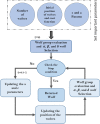Automatic diagnosis of schizophrenia and attention deficit hyperactivity disorder in rs-fMRI modality using convolutional autoencoder model and interval type-2 fuzzy regression
- PMID: 37974583
- PMCID: PMC10640504
- DOI: 10.1007/s11571-022-09897-w
Automatic diagnosis of schizophrenia and attention deficit hyperactivity disorder in rs-fMRI modality using convolutional autoencoder model and interval type-2 fuzzy regression
Abstract
Nowadays, many people worldwide suffer from brain disorders, and their health is in danger. So far, numerous methods have been proposed for the diagnosis of Schizophrenia (SZ) and attention deficit hyperactivity disorder (ADHD), among which functional magnetic resonance imaging (fMRI) modalities are known as a popular method among physicians. This paper presents an SZ and ADHD intelligent detection method of resting-state fMRI (rs-fMRI) modality using a new deep learning method. The University of California Los Angeles dataset, which contains the rs-fMRI modalities of SZ and ADHD patients, has been used for experiments. The FMRIB software library toolbox first performed preprocessing on rs-fMRI data. Then, a convolutional Autoencoder model with the proposed number of layers is used to extract features from rs-fMRI data. In the classification step, a new fuzzy method called interval type-2 fuzzy regression (IT2FR) is introduced and then optimized by genetic algorithm, particle swarm optimization, and gray wolf optimization (GWO) techniques. Also, the results of IT2FR methods are compared with multilayer perceptron, k-nearest neighbors, support vector machine, random forest, and decision tree, and adaptive neuro-fuzzy inference system methods. The experiment results show that the IT2FR method with the GWO optimization algorithm has achieved satisfactory results compared to other classifier methods. Finally, the proposed classification technique was able to provide 72.71% accuracy.
Keywords: ADHD; CNN-AE; Diagnosis; GWO; IT2FR; Schizophrenia; fMRI.
© The Author(s), under exclusive licence to Springer Nature B.V. 2022. Springer Nature or its licensor (e.g. a society or other partner) holds exclusive rights to this article under a publishing agreement with the author(s) or other rightsholder(s); author self-archiving of the accepted manuscript version of this article is solely governed by the terms of such publishing agreement and applicable law.
Figures





















Similar articles
-
Metaheuristic Spatial Transformation (MST) for accurate detection of Attention Deficit Hyperactivity Disorder (ADHD) using rs-fMRI.Annu Int Conf IEEE Eng Med Biol Soc. 2020 Jul;2020:2829-2832. doi: 10.1109/EMBC44109.2020.9176547. Annu Int Conf IEEE Eng Med Biol Soc. 2020. PMID: 33018595
-
Classification of drug-naive children with attention-deficit/hyperactivity disorder from typical development controls using resting-state fMRI and graph theoretical approach.Front Hum Neurosci. 2022 Aug 18;16:948706. doi: 10.3389/fnhum.2022.948706. eCollection 2022. Front Hum Neurosci. 2022. PMID: 36061501 Free PMC article.
-
Adaptive fuzzy deformable fusion and optimized CNN with ensemble classification for automated brain tumor diagnosis.Biomed Eng Lett. 2021 Nov 7;12(1):37-58. doi: 10.1007/s13534-021-00209-5. eCollection 2022 Feb. Biomed Eng Lett. 2021. PMID: 35186359 Free PMC article.
-
Learning a Phenotypic-Attribute Attentional Brain Connectivity Embedding for ADHD Classification using rs-fMRI.Annu Int Conf IEEE Eng Med Biol Soc. 2020 Jul;2020:5472-5475. doi: 10.1109/EMBC44109.2020.9175789. Annu Int Conf IEEE Eng Med Biol Soc. 2020. PMID: 33019218
-
Identifying individuals with attention-deficit/hyperactivity disorder based on multisite resting-state functional magnetic resonance imaging: A radiomics analysis.Hum Brain Mapp. 2023 Jun 1;44(8):3433-3445. doi: 10.1002/hbm.26290. Epub 2023 Mar 27. Hum Brain Mapp. 2023. PMID: 36971664 Free PMC article.
Cited by
-
Using artificial intelligence methods to study the effectiveness of exercise in patients with ADHD.Front Neurosci. 2024 Apr 23;18:1380886. doi: 10.3389/fnins.2024.1380886. eCollection 2024. Front Neurosci. 2024. PMID: 38716252 Free PMC article.
-
Multimodality model investigating the impact of brain atlases, connectivity measures, and dimensionality reduction techniques on Attention Deficit Hyperactivity Disorder diagnosis using resting state functional connectivity.J Med Imaging (Bellingham). 2024 Nov;11(6):064502. doi: 10.1117/1.JMI.11.6.064502. Epub 2024 Dec 20. J Med Imaging (Bellingham). 2024. PMID: 39713730
-
BlobCUT: A Contrastive Learning Method to Support Small Blob Detection in Medical Imaging.Bioengineering (Basel). 2023 Nov 29;10(12):1372. doi: 10.3390/bioengineering10121372. Bioengineering (Basel). 2023. PMID: 38135963 Free PMC article.
-
A Computerized Analysis with Machine Learning Techniques for the Diagnosis of Parkinson's Disease: Past Studies and Future Perspectives.Diagnostics (Basel). 2022 Nov 5;12(11):2708. doi: 10.3390/diagnostics12112708. Diagnostics (Basel). 2022. PMID: 36359550 Free PMC article. Review.
-
Weaker top-down cognitive control and stronger bottom-up signaling transmission as a pathogenesis of schizophrenia.Schizophrenia (Heidelb). 2025 Mar 5;11(1):36. doi: 10.1038/s41537-025-00587-0. Schizophrenia (Heidelb). 2025. PMID: 40044672 Free PMC article.
References
-
- Alizadehsani R, Sharifrazi D, Izadi NH, Joloudari JH, Shoeibi A, Gorriz JM, Acharya UR. Uncertainty-Aware Semi-supervised method using large unlabeled and limited labeled COVID-19 Data. ACM Trans Multimed Comput Commun Appl (TOMM) 2021;17(3):1–24.
-
- Anter AM, Abd Elaziz M, Zhang Z. Real-time epileptic seizure recognition using Bayesian genetic whale optimizer and adaptive machine learning. Futur Gener Comput Syst. 2022;127:426–434. doi: 10.1016/j.future.2021.09.032. - DOI
LinkOut - more resources
Full Text Sources

